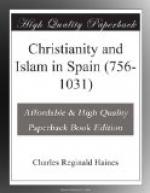[1] See sec. 2, and Eul.,
“Ad Wiliesindum,” where he speaks of
the road to Gaul as “stipata
praedonibus,” and of all Gothia as
“perturbata funeroso
Wilihelmi incursu.”
On reaching Cordova, after many days, they go to St Cyprian’s Church, where lay the bodies of John and Adulphus. The rumour of their arrival brings Leovigild (called Abad Salomes), who proves a very useful friend, and Samson, who just at this juncture is made abbot of the monastery at Pegnamellar, where the bodies of George, Aurelius, and Sabigotha were buried—the very relics which they had decided to try and obtain.
The monks of the monastery naturally object to parting with such precious possessions, but Samson contrives to get the bishop’s permission to give up the bodies.
This was all the more opportune, as a chance was now given them of returning to Barcelona, by joining the expedition which Mohammed I. was on the point of making against Toledo. Orders had been given that all the inhabitants, strangers as well as citizens, except the city guard, should go out with the King. However, the Frankish monks were met by an unexpected difficulty. In the temporary absence of the abbot, the monks of Pegnamellar refused to give up the relics, and it was only with much difficulty that the bishop Saul was induced to confirm his former permission to remove them.
The bodies were now exhumed without the knowledge of the Moslems, and sealed with Charles’ own seal, brought for that purpose. George’s body was found whole, but of the other two, only the head of Nathalia, and the trunk of Aurelius’ body. The two latter are united to form one corpse, as it is written, “they two shall be one flesh.” After a stay in Cordova of eight weeks, they set out under the protection of some Christians serving in the army. Leovigild, who had been away on the King’s business, now returns, and escorts them to Toledo. The approach of the army having cleared away the brigands who infested those parts, the monks with their precious freight got safely away to Saragoza, and returned with their booty to France, where the relics worked numbers of astonishing miracles.
Let us return from this digression to the steps taken by the moderate party among the Christians, and by the Moslem authorities, to put an end to what seemed so dangerous an agitation. That Reccafredus was not the only ecclesiastic of high position who took exception to the new movement we learn clearly enough from Alvar,[1] who tells us that “bishops, priests, deacons, and ‘wise men’ of Cordova joined in inveighing against the new martyrdoms, under the impulse of fear wellnigh denying the faith of Christ, if not in words, yet by their acts.” We may, therefore, conclude that the greater part of the ecclesiastical authorities were heart and soul with the Bishop of Seville, while the party led by Eulogius and Saul was a comparatively small one. However, strong measures were necessary, and Reccafredus did




